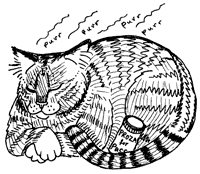STRANGE BUT TRUE- Tranquil tabby: Prozac helps keep pets purring

DRAWING BY DEBORAH DERR McCLINTOCK
Q. What are all those pets doing taking Prozac-like medications? If they're depressed, they certainly can't tell anybody about it. –A. Pontuso
A. Psychiatric drugs have been used to help with dogs that obsessively lick their paws, cats that spray walls with urine, pet parrots that might self-mutilate when bored, zoo animals suffering outside their natural habitat, reports the Atlanta Journal Constitution. The overall aims are to do what is humanly possible to protect animals from self-injury and to improve quality of life (Journal of Exotic Pet Medicine).
Dog owners try to stave off problem behaviors such as howling or destructiveness that can lead to veterinary euthanasia, says John Bonner in New Scientist magazine. A reported 25 percent of dogs euthanized fit the behavioral category. Dogs have long been given tranquilizers to calm them during holiday fireworks and the like. Now a new antidepressant called "Reconcile" has been licensed for use with dogs, containing the same serotonin reuptake inhibitor used in the human drug Prozac. There are critics of the approach, but United Kingdom veterinary behaviorist Daniel Mills says human psychiatric drugs have been used successfully for many years in treating animals, as the clinical features of depression are "very similar" in humans and dogs. The key differences with the new drug are dosage reformulation and an added beef flavor. But Mills stresses that no responsible vet would rely solely on drug therapy, ignoring the behavioral inputs to the problem.
Q. What's the "Donald Duck gas" that can get a laugh at times but all too often winds up being the prankster's last laugh? –W. Rodman
A. Helium, which when inhaled into the vocal tract creates an air-helium mixture where the speed of sound jumps from maybe 340 meters per second in just air up to 900 mps, says Jearl Walker in The Flying Circus of Physics. Now on comes the Disney duck, as the higher frequencies of oscillation of the vocal folds result in the distinctive voice sounds.
The danger here is obvious: You can live only if you breathe oxygen, but if you foolishly fill your lungs with helium, you can no longer breathe in air. As the oxygen level in your blood drops, you might not be able to get the helium back out and the air back in fast enough to avoid suffocating or your brain undergoing oxygen starvation.
"We all have to die someday, but this is a really stupid way to do it," Walker says.
Q. Why is it that "Time flies when you're having fun" and "A watched pot never boils"? –J. Child
A. Brain resources for paying attention to anything are limited, so when you're really engrossed in an enjoyable activity, you can't think much about the passage of time, says Jay Ingram in The Velocity of Honey. So you're fooled into thinking that less time has passed. Of course, when you're thinking of nothing but time, it expands, as with the watched pot. An irony about a fast, fun time is that when you think back on it, memory will actually make it seem longer than it was.
Another time oddity is the "tourist illusion." When you travel by car to a place you've never been before, then come back the same route, the trip out always seems to take much longer, probably due to anticipation and suspense.
Get a fever, and your biological clocks may go crazy: once when biochemist Hudson Hoagland's wife was bedridden with a fever of 40 C (104 F), she sent him on an errand to the drugstore. Though he was gone only 20 minutes, she insisted it was much longer. Ever the scientist, Hoagland put her to the test, asking her to judge the passage of a minute by counting off the seconds. The higher her fever, the faster her count. Apparently during his errand, her clock had "ticked over more than usual."
Q. Some blind people can walk unaided down busy streets, uncannily avoiding obstacles. One six-year old could even ride a tricycle. How is this possible? –M. Magoo
A. People with this ability say they feel a kind of shadow or pressure on the face that warns of approaching
objects, says John Downer in Supersense. But when they're tested with ears plugged, this mysterious "facial vision" disappears. Echolocation– as used by bats and dolphins– seems to be their secret. The reflected sounds of footsteps, conversation, or deliberately issued tongue clicks or cane taps provide the clues. The estimated time required for an echo's return indicates distance to the obstacle, while echo loudness signals the size.
Send Strange questions to brothers Bill and Rich at [email protected].
#
2 comments
My local newspaper (Pocono Record, Stroudsburg PA)
published your question and answer about whether 1.0 is bigger than 0.9999999... Your answer was neither strange nor true. Your answer states that 1/3=0.3333... and 2/3=0.6666... Actually, 0.3333... and 0.6666... approximate, but will never equal, 1/3 and 2/3. Using "equal" is a matter of convenience, not fact.
This response is incorrect. 1/3 does in fact equal 0.33333... where the 3's repeat FOREVER. There are an infinite number of decimal places and 0.3333... is only a less convenient way to represent it than as a fraction. Technically the last 3 should have a bar over it or there should be 3 dots after the end of the number to indicate it repeats forever. Lots of mathematical objects have an infinite number of terms. Take, for example, any algebraic series that represents e^x or any of the basic trig functions (sin(x), cos(x) etc). Also, ANY irrational number has an infinite numbers of terms (Pi or sqrt(2) for example). I know I'm coming in on the end of the discussion but Mr. Arensbergs answer about the equality of the decimal (when properly notated) vs fraction representation is not correct.